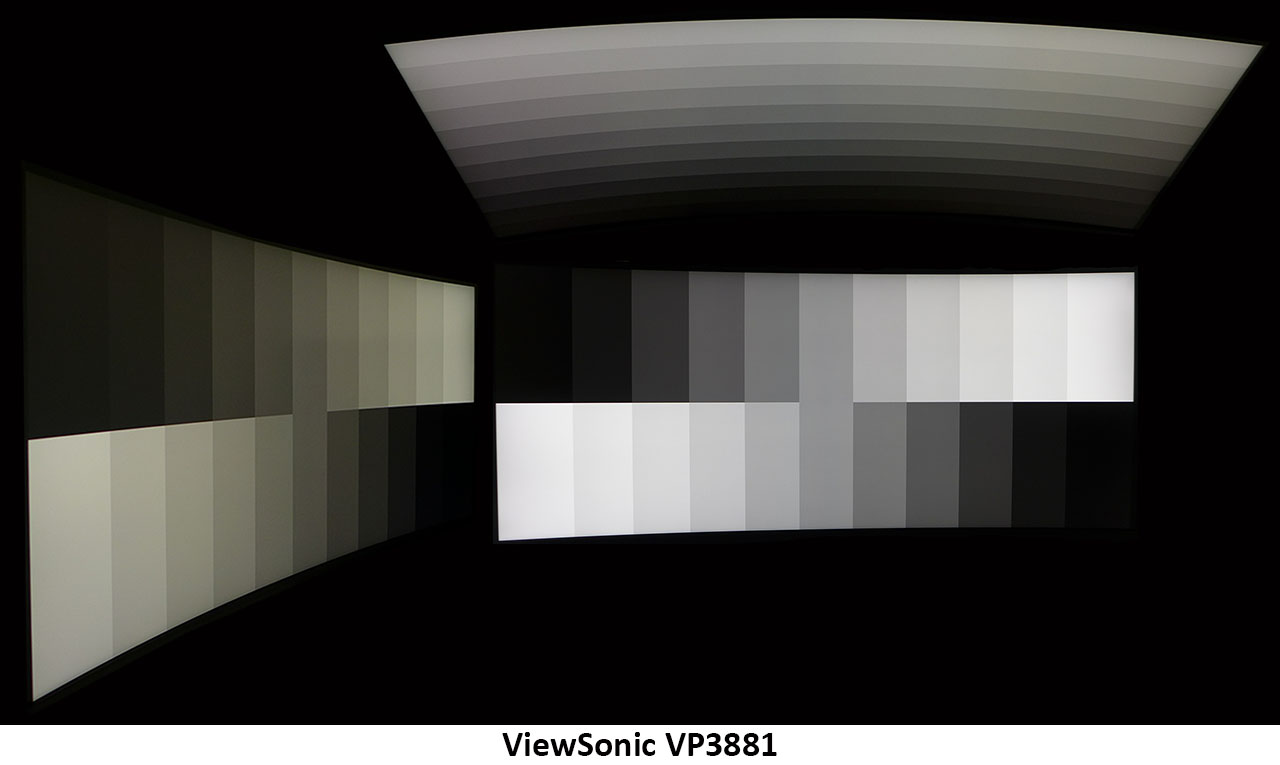ViewSonic VP3881 38" Curved HDR Monitor Review: Professional sRGB
Why you can trust Tom's Hardware
Viewing Angles, Uniformity, Response & Lag
Viewing Angles
The VP3881 shows off-axis image quality typical of high-end IPS panels. At 45° to the sides, light output is reduced by 40% and there is a pronounced green shift. From the top, detail is substantially reduced. While this is better than a VA monitor can boast, it still pales in comparison to an OLED screen. That’s a technology we all hope comes to the desktop soon. For now, IPS is as good as it gets, and we have no issues with this ViewSonic. Look at it head-on from about 36 inches away, and you’ll be fine.
Screen Uniformity
To learn how we measure screen uniformity, click here.
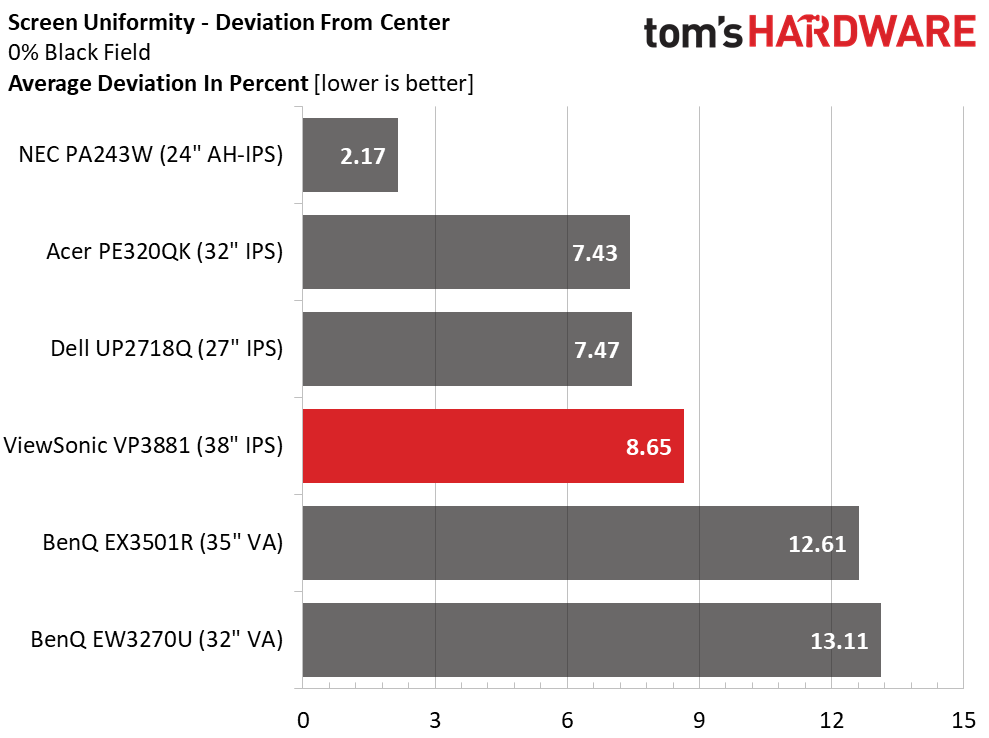
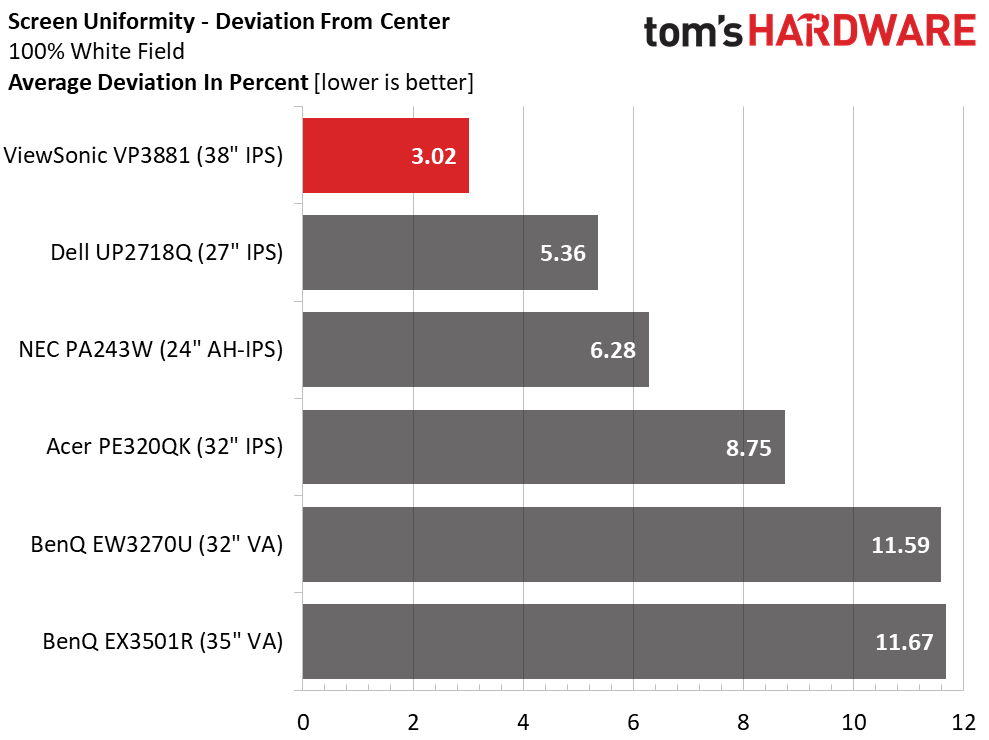
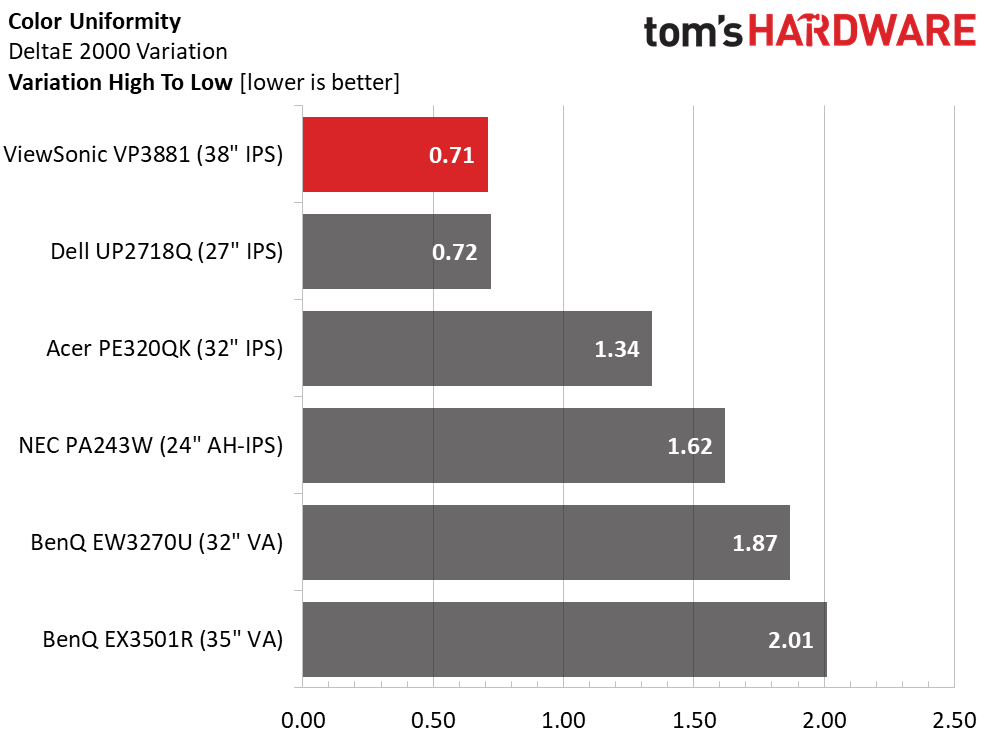
The VP3881 includes a uniformity compensation feature, but we avoided it for three reasons. First, it’s only available in the fixed color modes. And some of them lock out the brightness slider when it’s turned on. Second, it reduces both output and contrast by half. And third, it’s clearly not necessary. Our tests show the panel’s native state, which is quite good. 8.65% is a superb black field result, especially for a curved screen. And 3.02% is one of the lowest white field values we’ve ever recorded. The color test result is only approached by the UP2718Q, which comes within .01dE of the ViewSonic (that’s also a near-record measurement).
Pixel Response & Input Lag
Click here to read up on our pixel response and input lag testing procedures.
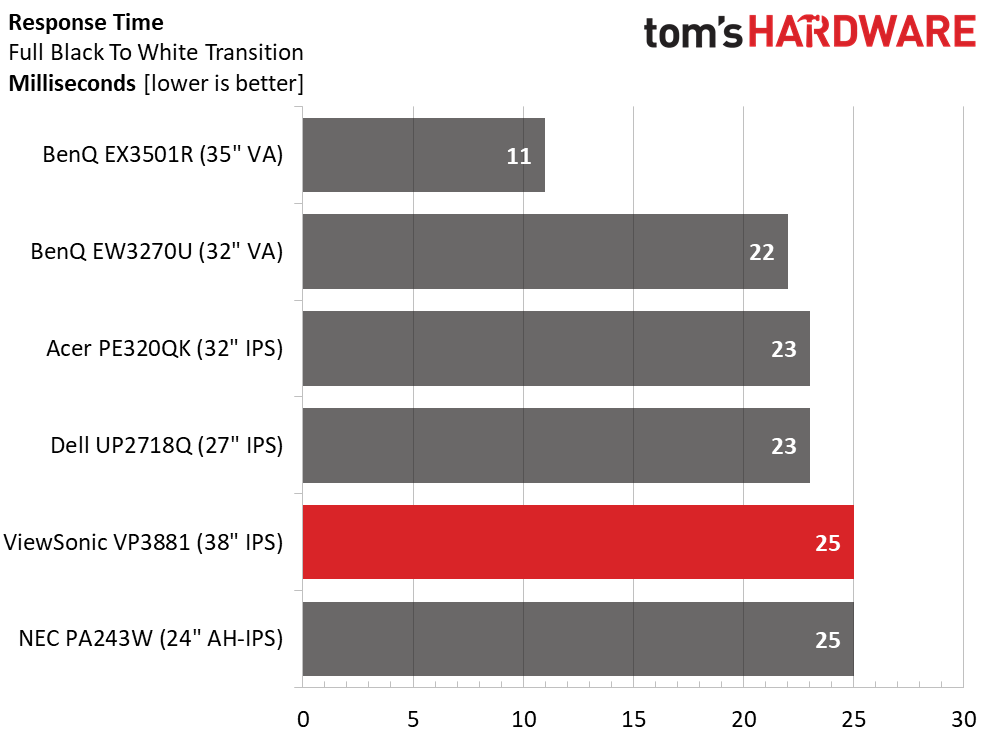
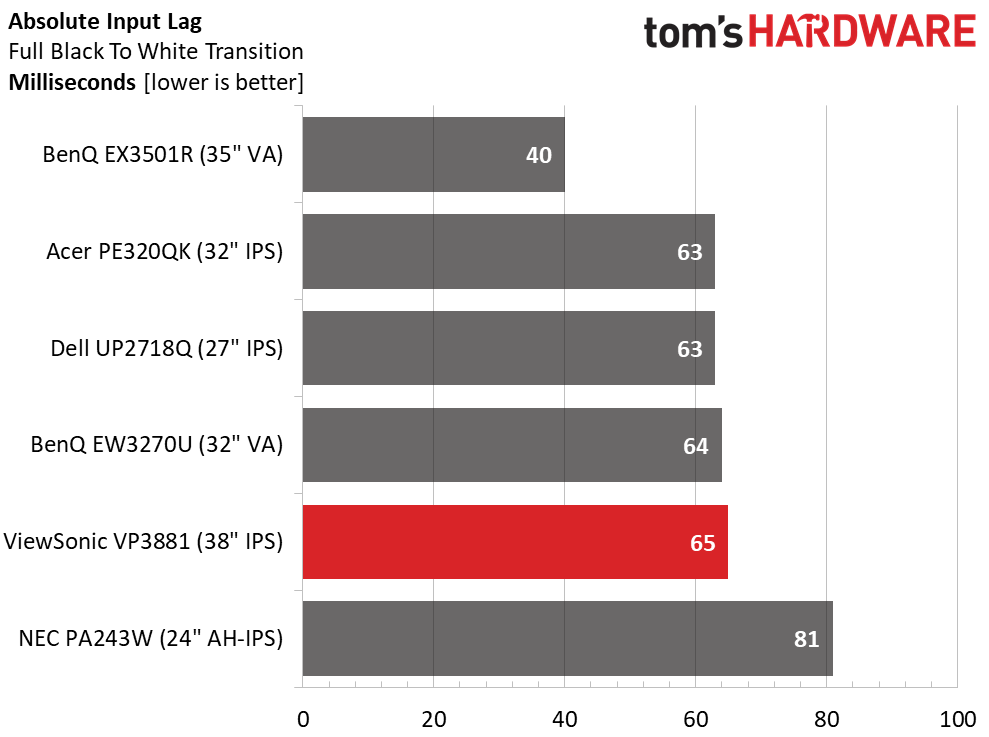
The VP3881 makes no claims about being a gaming monitor, but there are gaming modes and low input lag settings available in the OSD. However, these won’t help it rise above the average 60Hz screen. Most professional and business-class displays draw the screen in around 25ms and deliver input lag in the mid-60s. While this is fine for casual play, serious gamers will not be considering this product. The overdrive feature helps keep motion blur under control, but if your reflexes are quick, the lag might be a problem. And without adaptive sync, those who have been spoiled by FreeSync and G-Sync won’t want to play without it.
MORE: Best Gaming Monitors
MORE: How We Test Monitors
Get Tom's Hardware's best news and in-depth reviews, straight to your inbox.
MORE: All Monitor Content
Current page: Viewing Angles, Uniformity, Response & Lag
Prev Page HDR Grayscale, EOTF, & Color Next Page Conclusion
Christian Eberle is a Contributing Editor for Tom's Hardware US. He's a veteran reviewer of A/V equipment, specializing in monitors. Christian began his obsession with tech when he built his first PC in 1991, a 286 running DOS 3.0 at a blazing 12MHz. In 2006, he undertook training from the Imaging Science Foundation in video calibration and testing and thus started a passion for precise imaging that persists to this day. He is also a professional musician with a degree from the New England Conservatory as a classical bassoonist which he used to good effect as a performer with the West Point Army Band from 1987 to 2013. He enjoys watching movies and listening to high-end audio in his custom-built home theater and can be seen riding trails near his home on a race-ready ICE VTX recumbent trike. Christian enjoys the endless summer in Florida where he lives with his wife and Chihuahua and plays with orchestras around the state.
-
emeraldsmines1990 To all Monitors makers , we demand more height wide screens ... stop focusing on gaming monitors and bring us please WIDE AND TALL Monitors.Reply
For productivity , that is :
3840 x 2400 Resolution and not Curved.
-
Rushnerd I have one of these except it's acer and way cheaper. It's taller than my old 27" and the resolution, while not true 4K, is still more than enough, especially trying to run games faster than 75hz.Reply
Plus the curve on this thing is pretty subtle and with a panel this wide, it's pretty helpful. -
WINTERLORD i agree i really like the monitor reviews they have here at toms hardware. in paticuler the gaming and HDR and even budget HDRReply -
photonboy EMERALDSMINES1990,Reply
Uh...what do you mean by "wide and tall" anyway?
Wide and Ultrawide are references to the Aspect Ratio being more wide than it is tall. You can't be both wider and taller at the same time in terms of Aspect.
Or maybe you just mean physically wider (i.e. 30"+) while having both high pixel density and 16:10 (less wide) aspect ratio?
Also, being CURVED is a necessity for most if the monitor is PHYSICALLY TOO WIDE regardless of Aspect Ratio... of course you can sit further BACK from the monitor so you don't keep turning your head off axis and distorting the text so much but that defeats the purpose too of getting a large monitor.
And is there really that much demand for 16:10 these days? If you had something like a 30", 3840x2160 (4K) monitor there's lots of pixels to work with. Does it really need to be TALLER than this?
I think the original point of 16:10 was that two 8:10 pages could be next to each other but then when 16:9 became standard games and video optimized for this ratio so the demand really dropped.
I guess I just don't see much demand for super large, 16:10 monitors. -
hotaru251 assume they meant they want screens like in CRT days...Reply
where you have a more square (ish) screen ratehr than a longer only screen.
I could udnerstand not wanting a screen that is 3x as long as it is tall. -
totaldarknessincar Dear Monitor makers and Tomshardware.Reply
We don't want to read reviews of monitors with technology we have seen before. the LG 38UC99 came out 2 years ago. Then we had the ACER 38 inch ultrawide. Then we had the HP 38 inch ultrawide, followed by the Dell 38 inch ultrawide, there may have been another company, even LG updated the 38uc99 to make way for 38WK95C; and now viewsonic.
They are all base on LG's screen, they are all missing displayport 1.4 for some odd reason despite the 1000-1300 premium price rage and displayport 1.4 has been certified for years now. They are are barely able to get 75 refreshes, they all are freesync only, despite NVIDIA GPUs dominating the high end space, they are don't have wide, DCI P3 color gamuts, they are have crappy contrast ration that in practice is only like 800:1, they all aren't bright, peaking at about 300 nits, and they all are curved.
Please wake me up when we have
38 inch ultrawide or any 38 inch monitor
that is not curved
That can do 100hz minimum
That is truly 4K (i'm not paying 1300 for a monitor that i plan on having for 6+ years (I bought a dell u3011 in 2010 and I'm still using it now (8 years)). 4K will for sure be the standard in 6-8 years for most medium to high end monitors and to already not have it, is setting yourself up for failure.
-It needs to have at least 600 nits
-HDR
-Basically take that LG 5K monitor that is about to come out, that is 34 inches, and increase the size, increase the refresh, add HDR, add displayport 1.4 and we are set. -
emeraldsmines1990 Reply21139859 said:EMERALDSMINES1990,
Uh...what do you mean by "wide and tall" anyway?
Wide and Ultrawide are references to the Aspect Ratio being more wide than it is tall. You can't be both wider and taller at the same time in terms of Aspect.
Or maybe you just mean physically wider (i.e. 30"+) while having both high pixel density and 16:10 (less wide) aspect ratio?
Also, being CURVED is a necessity for most if the monitor is PHYSICALLY TOO WIDE regardless of Aspect Ratio... of course you can sit further BACK from the monitor so you don't keep turning your head off axis and distorting the text so much but that defeats the purpose too of getting a large monitor.
And is there really that much demand for 16:10 these days? If you had something like a 30", 3840x2160 (4K) monitor there's lots of pixels to work with. Does it really need to be TALLER than this?
I think the original point of 16:10 was that two 8:10 pages could be next to each other but then when 16:9 became standard games and video optimized for this ratio so the demand really dropped.
I guess I just don't see much demand for super large, 16:10 monitors.
For Productivity 4:3 is the best . and if you look at Famous Tablet makers they realized that 4:3 is the best and Apple IPAD is 4:3 the same as Samsung Tab S3 ...
it is the best for productivity, when they moved to wide screens 16:9/16:10 (FHD) people loved it for watching movies mostly nothing more.
4:3 is the best , and the Tablet makers figured it out very well.
Samsung Tab s3
9.7” QXGA (2048 x 1536)
4:3
and Ipad Pro
2224x1668
4:3 as well.
and I personally like to game on 4:3 because I want to see more vertical the same I want to see more horizontal.
Even the MS surface is 2256 x 1504 (3:2)
Edit : Let me explain more why 4:3 is better than wide screens for work ..
first of all if one application , you will have bigger space to work with all directions .
now for multi windows , in wide screen , people will split it left right and never up down because it is wide.
here each part on right and left , will need to scroll in all directions because the width is half and the height is lower than 4:3 ..
However , if you have 4:3 monitor and you split the screen up and down using two apps , Both will have full width and the only scrolling you will need is up and down , not all directions. Also , having the width maximized in the upper up and lower app , is much easier to work with and monitor.
and so on. -
therealduckofdeath Try an Ultrawide first, EMERALDSMINES1990. You'll realise that a huge 4:3 display is exceptionally bad for productivity. You'll ruin your neck in a few days as our heads and eyes move excellently from side to side while they don't enjoy up and down as much. If a 4:3 display would be as wide as this it would have to be placed on the floor to work ergonomically.Reply
The Ultrawide makes sense, as you get more workspace without having to split your area over two displays. The curve also makes sense as it counters the warping effect you otherwise get with that much display so close to your face. -
Rushnerd Replyemeraldsmines1990 "I personally like to game on 4:3 because I want to see more vertical the same I want to see more horizontal."
I can do 4:3 in considerable size on my 38" Acer display, but the "productivity" you mentioned? This monitor is equal to over 3 1080p monitors and the size gets around 4K scaling issues.
If you haven't tried ultrawide gaming yet, you really should. That said i've been playing some 4:3 games lately, and other 4:3 ones modded for ultrawide, it's great.
I also want to add that I thought a 38" 3840X1600 monitor was completely overkill and too much, but it's even better than the last acer 34" ultrawide I used. It's hard to put into words what it's like to be almost completely surrounded by a game in nearly 4K.
EDIT: I do youtube videos for my channel a lot and they have made 21:9 more or less the new standard for 16:9 screens along with the fact that editing videos at this res and size is a dream come true.
therealduckofdeath
I bought a 40" Tv once years ago as a monitor, it's only 2" bigger than this one, but that tv was so tall and big that it was impossible to use and hurt!
"You'll realise that a huge 4:3 display is exceptionally bad for productivity. You'll ruin your neck in a few days as our heads and eyes move excellently from side to side while they don't enjoy up and down as much." -
emeraldsmines1990 Reply21142360 said:Try an Ultrawide first, EMERALDSMINES1990. You'll realise that a huge 4:3 display is exceptionally bad for productivity. You'll ruin your neck in a few days as our heads and eyes move excellently from side to side while they don't enjoy up and down as much. If a 4:3 display would be as wide as this it would have to be placed on the floor to work ergonomically.
The Ultrawide makes sense, as you get more workspace without having to split your area over two displays. The curve also makes sense as it counters the warping effect you otherwise get with that much display so close to your face.
Ultra Wide is for gaming only . for productivity 4:3 is way better. a 30 inch 4:3 is good enough size and wont be that big.
keep in mind that many people when they used 3 monitors setup for gaming they put them in vertical mode (pivoted) so not all people really prefer ultra wide over 4:3
example
https://www.youtube.com/watch?v=MJNkwlSqXUM
